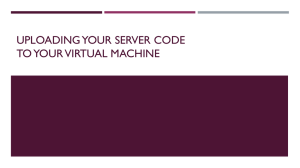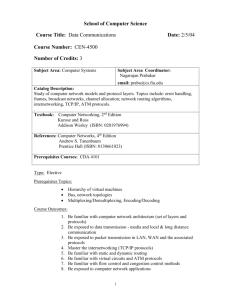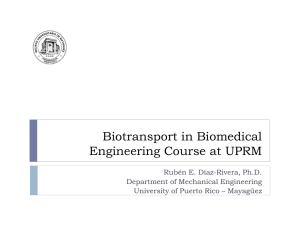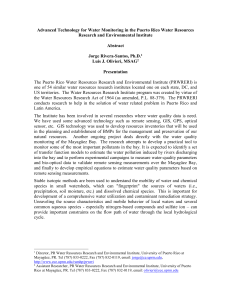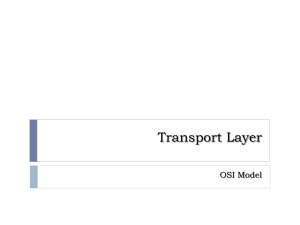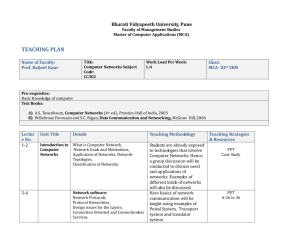UPRM
advertisement
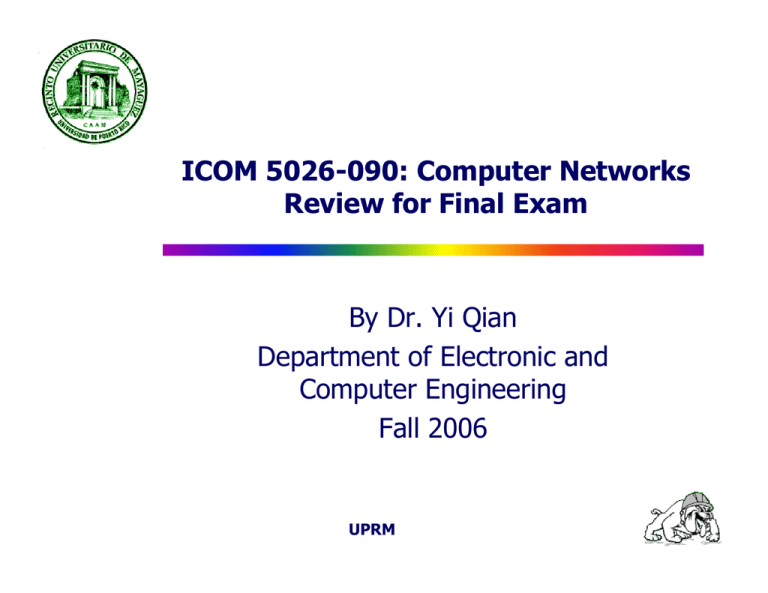
ICOM 5026-090: Computer Networks Review for Final Exam By Dr. Yi Qian Department of Electronic and Computer Engineering Fall 2006 UPRM Chapter 1: Introduction to Computer Networks • What is a computer network? • What is a distributed system? • What are the differences between a distributed system and a computer network? • The client-server model • Peer-to-peer model 2 UPRM Chapter 1: Introduction to Computer Networks Size of Networks 3 UPRM Chapter 1: Introduction to Computer Networks Network Software: Important Concepts • • • • • • Protocol Protocol Hierarchies Interface Service Service Primitive Relationship of Service and Protocol 4 UPRM Chapter 1: Introduction to Computer Networks ISO/OSI Reference Model 5 UPRM Chapter 1: Introduction to Computer Networks ISO/OSI Model / 7 Layers • Physical Layer: provide transmission channel • Data link Layer: provide reliable communication (ACK) • Network Layer: Control the operation of subnet – Routing, congestion control, quality of service • Transport Layer: accept upper packets, split if necessary, pass to network layer, ensure arrive correctly • Session Layer: allows users on different machines to establish sessions between them • Presentation Layer: is concerned with the syntax and semantics of the information transmitted • Application Layer: contains a variety of protocols that are commonly needed by users 6 UPRM Chapter 1: Introduction to Computer Networks TCP/IP Reference Model 7 UPRM Chapter 1: Introduction to Computer Networks TCP/IP Layers • Internet – Connectionless – Interface: send, receive • Transport – UDP: User datagram protocol • Connectionless • Unreliable, connectionless – TCP: transmission control protocol • Connection oriented • Reliable, connection-oriented, with flow control • Application – Telnet, FTP, SMTP, DNS, HTTP 8 UPRM Chapter 1: Introduction to Computer Networks TCP/IP Reference Model 9 UPRM Chapter 1: Introduction to Computer Networks • The similarity and differences between ISO/OSI and TCP/IP models? 10 UPRM Chapter 2: The Physical Layer • Important Concepts – Bandwidth • Decibel (dB) – The dB value is calculated by taking the log of the ratio of the measured or calculated power (P2) with respect to a reference power (P1). • dB=10 x log_10 (P2/P1) – 0 dBW = 1 watt – 0 dBm = 1 milliwatt = 0.001 watt – * For amplitude, we shall use • dB=20 x log_10 (A2/A1) • Example: P=V^2/R 11 UPRM Chapter 2: The Physical Layer Maximum Data Rate of A Channel • Nyquist theorem – A signal passes through a lowpass filter with bandwidth H – The output signal can be completely reconstruct by making 2H samples per second – Max data rate = 2H log_2 V bits/sec • V is the number of discrete level of the signal – Condition: noiseless system 12 UPRM Chapter 2: The Physical Layer Maximum Data Rate of A Channel • In a noisy condition, the signal-to-noise ratio SNR is defined as – – – – S/N S: power of the signal N: power of the noise 10*log_10 (S/N) is often used • Shannon capacity – Max number of bits per sec= H log_2 (1+S/N) – Example: H=3,000Hz, S/N=30dB • Max data rate = 30,000 bps 13 UPRM Chapter 3: The Data Link Layer • DLL Design Issues – Services Provided to the Network Layer – Framing • To determine the start and end of a frame – Error Control • To provide reliable communications – Flow Control • To regulate the transmission of sender – Example: fast sender and slow receiver • Possible Service – Unacknowledged connectionless service – Acknowledged connectionless service – Acknowledged connection-oriented service 14 UPRM Chapter 3: The Data Link Layer • Framing – – – – • Error Detection and Correction – – • • • • • • Error-Correcting Codes Error-Detecting Codes Codeword Hamming Distance & Hamming Code Parity Polynomial Code CRC Algorithm Elementary Data Link Protocols – – – • Character count Flag bytes with byte stuffing Starting and ending flags with bit stuffing Physical layer coding violations An Unrestricted Simplex Protocol A Simplex Stop-and-Wait Protocol A Simplex Protocol for a Noisy Channel Sliding Window Protocols – – – 15 A One-Bit Sliding Window Protocol A Protocol Using Go Back N A Protocol Using Selective Repeat UPRM Chapter 4: The Medium Access Control Sublayer • Static Channel Allocation – – – TDM FDM Problem • Might not be efficient if – – • Dynamic Channel Allocation – – – – – – • 1. Station Model 2. Single Channel Assumption 3. Collision Assumption 4.(a) Continuous Time 4.(b) Slotted Time 5.(a) Carrier Sense 5.(b) No Carrier Sense Multiple Access Protocols – – – – • • The number of users is large and continuously varying, or The traffic is bursty ALOHA Carrier Sense Multiple Access Protocols Collision-Free Protocols Limited-Contention Protocols Ethernet, Fast Ethernet, Gigabit Ethernet 802.2 Logical Link Control 16 UPRM Chapter 5: The Network Layer • Services Provided to the Transport Layer – – • Connectionless Connection-oriented The Internet – – Traditionally, Internet only provide the connectionless services in the network layer The next generation Internet may provide connection-oriented services • • • • • • Implementation of Connectionless Service Implementation of Connection-Oriented Service Comparison of Virtual-Circuit and Datagram Subnets Routing Algorithms – – – – – – – • Quality-of-service concerns Efficiency concerns The Optimality Principle Shortest Path Routing Flooding Distance Vector Routing Link State Routing Hierarchical Routing Broadcast Routing The Network Layer in the Internet – – 17 The IP Protocol IP Addresses UPRM Chapter 6: The Transport Layer • What is the functionality of transport layer? • The Internet transport protocol: UDP • The Internet transport protocol: TCP 18 UPRM
